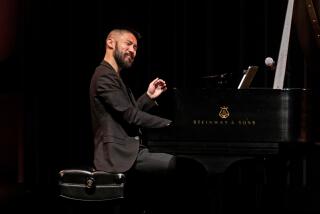MUSIC REVIEW : Guitarist Starobin Plays Regondi
- Share via
Whatever other qualities emerged Monday night, when guitarist David Starobin gave his debut recital at Ambassador Auditorium, perhaps the most lasting impression was its air of discovery.
In a sense, the evening belonged to the obscure mid-19th-Century composer Giulio Regondi, who, in addition to writing rigorous music, reportedly played the guitar, the concertina and sang with a brilliance that impressed the likes of Fernando Sor and Paganini.
It was, of course, from the guitar component of the composer’s output that Starobin drew his Regondi program, in addition to one brief transcription of a concertina work. (One rationale for Regondi’s present-day obscurity was the meteoric rise and fall of the concertina, for which he wrote extensively.)
Starobin possesses a striking command of his instrument, as heard here on a replica of a 19th-Century model, with a smaller, more intimate tone. Yet the guitarist’s name has also become synonymous with a crusading effort to expand the repertory of the classical guitar. Whereas Starobin has inspired a bounty of new music from living composers, he has also championed Regondi’s music of late, particularly since the discovery of 10 long-sought-after guitar etudes in Russia.
As heard here, those etudes embody an important contribution to guitar literature. In particular, the Etude No. 2 in A minor shifts from a romantic patina to a harmonically restless middle section, modulating hither and yon before finding a path back to the home key. Etude No. 7 in D balances Romantic spirit with Classical composure and logic.
Starobin’s transcription of a Concertina Waltz found ardent romanticism interlaced with quirky wit in the form of gestural fingerboard hiccups. With Regondi’s Air and Variations virtuosic demands are placed on the guitarist, belying the seeming fluidity of the writing. Clearly, this is challenging stuff, despite its silken emotional flow.
Closing the recital with a tour de force, Starobin maneuvered the tight turns, capricious mood and fiendish ornamentations of the Introduction and Caprice, Opus 23.
More to Read
The biggest entertainment stories
Get our big stories about Hollywood, film, television, music, arts, culture and more right in your inbox as soon as they publish.
You may occasionally receive promotional content from the Los Angeles Times.










